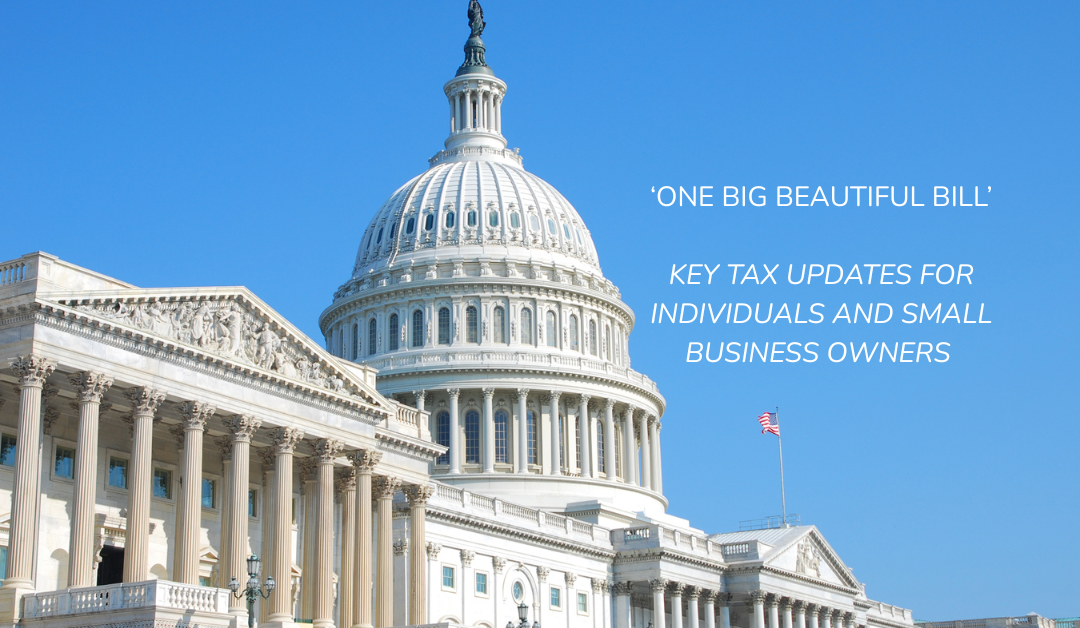
by Blair Butters | Aug 14, 2025 | General Tax and Accounting Information, IRS, Tax Credits, Tax Planning
What is the Big Beautiful Bill? Let’s cut through the noise. In July 2025, Congress passed a sweeping tax package officially known as the One Big Beautiful Bill (OBBB), later renamed H.R. 1. Whether you’re a homeowner, small business owner, electric vehicle driver, or someone who just wants to avoid IRS headaches, there are several tax changes that could directly impact your bottom line. Here’s what you need to know. Quick Highlights: OBBB 2025 Tax Changes For Individuals Tax Rates – 37% top rate made permanent SALT Cap – Raised to $40,000 in 2025 (with income limits) New Deductions (2025-2028) – Car loan interest (new U.S.-assembled vehicles), tip income, and overtime pay Senior Deduction – Up to $6,000 ($12,000 for couples) for those 65+ Home Energy Credits End – Must install by Dec. 31, 2025 EV Credits End – Must purchase and take delivery by Sept. 30, 2025 For Small Businesses QBI Deduction – Up to 20% made permanent Bonus Depreciation – 100% expensing made permanent Section 179 – Limit increased to $2.5M Energy-Efficient Deduction Ends – Must complete by June 30, 2026 1099 Threshold – Increases to $2,000 starting in 2026 What’s In It for Individuals and Families Tax Rates The OBBB permanently extended the tax rates passed in the Tax Cuts and Jobs Act (TCJA – 2017) with a top marginal tax rate of 37 percent. Without passage of the OBBB, marginal tax rates would have reverted to pre-TCJA rates, with a top marginal tax bracket of 39.6 percent starting in tax year 2026. SALT Limitations Increased The limitation on individual deductions for certain state and...

by Blair Butters | Mar 7, 2023 | Tax Credits
On August 16, 2022, President Biden signed into law the Inflation Reduction Act (IRA), which expanded and extended two nonrefundable tax credits meant to encourage individuals to invest in energy efficiency improvements or clean energy in their homes. The IRA also proposes to lower energy costs, increase cleaner production, and reduce carbon emissions by approximately 40% by 2030. Today, we’re breaking down these two tax credits, how they are changing, and how they will affect you as a homeowner in 2023 and beyond. Energy Efficient Home Improvement Credit Homeowners may be familiar with this first credit, the Nonbusiness Energy Property Credit, which expired at the end of 2021. The credit was extended for tax year 2022, using 2021 parameters, however, the IRA extended and significantly improved the credit for 2023 through 2032 and has given the credit a new name – the Energy Efficient Home Improvement Credit. The old credit, applicable prior to tax year 2023, was worth 10% of the costs of installing certain energy-saving improvements in your home, such as windows, doors, roofing, and insulation. The credit had lifetime limits on the amount of credit taken, such as an overall $500 lifetime limit and a $200 lifetime limit for new windows. This meant credits taken in previous years counted toward the limit. There were also some individual credit limits for any advanced air circulating fans ($50), any qualified natural gas, propane, or oil furnaces and hot water boilers ($150), and any single energy property item ($300), such as certain water heaters and heat pumps. In 2023, the credit is now equal to 30% of the costs...

by Blair Butters | Oct 26, 2021 | General Tax and Accounting Information, IRS, Tax Credits, Tax Planning
Now that the filing season for 2020 tax returns is over, it’s time to start thinking about next year’s tax return, which may look different from prior years because of the pandemic relief bills, tax law changes, updates, new rules, and annual inflation adjustments. The earlier you begin, the more you can potentially save, and to get a head start, we’re breaking down key tax changes to help you prepare for April 15. Check out this list of 6 tax changes so you can begin preparing today. Child tax credit For the tax year 2021, the child tax credit will be increased from $2,000 to $3,000 for children over age 5 and under age 18 and to $3,600 for children 5 and under. However, for those with modified adjusted gross income above $75,000 for individuals, $112,500 for heads-of-household, and $150,000 for married filing jointly, the credit is reduced gradually until the credit is $2,000 per dependent. The credit is further reduced for those with modified adjusted gross incomes of $400,000 for married filing jointly and $200,000 for all other filing statuses. The enhancement is that, generally, the credit is fully refundable and now includes children who are 17 years old. The credit is claimed on your tax return like in prior years. Another important change to note is that at least half of the credit is paid in advance with monthly installments that began in July and will end in December 2021. The other half of the credit is claimed on your 2021 tax return. You can opt out of the monthly payments using the tool at the IRS...





Recent Comments